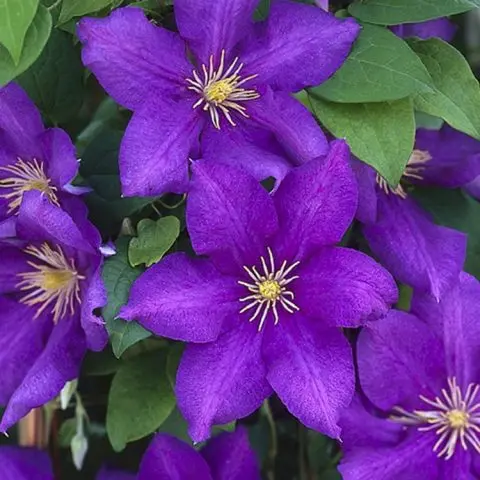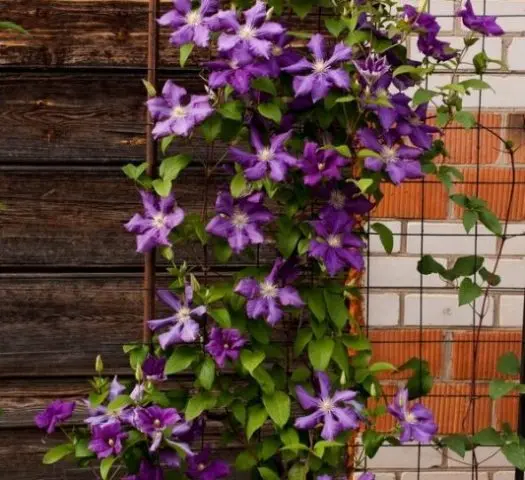Contents
Many gardeners for quite a long period of time believe that clematis is an exotic plant. Most mistakenly assume that almost all species, including Clematis Luther Burbank, have a capricious disposition, but this judgment is erroneous. Even a beginner in this business can acquire a beautiful liana in his own garden. Thanks to a wide assortment range, everyone will be able to choose the right variety of clematis.

Description of clematis Luther Burbank
Clematis varieties Luther Burbank are classified as single-color species, as a rule, this is a classic that will never go out of style. With the help of this plant, you can decorate not only flower beds, but also a gazebo, terrace, balcony. Flowering is plentiful, lasts a long time. The advantage is the fact that the plant is practically not susceptible to diseases.
Judging by the photo, Clematis Luther Burbank is a vigorous shrub liana that can reach a height of 2,5 to 4 m, in some cases even up to 5 m. The shoots have a red-brown tint. As a rule, up to 10 shoots appear on each bush.
The leaf plate is quite complex, and consists of 3-5 leaves. Flowers open wide and are large. For example, the diameter of flowers can vary from 16 to 20 cm. There are only 6 sepals, they have a pointed ellipsoid shape, wavy at the edges. The color is purple-violet, which fades in the summer, and becomes bright at low temperatures.
The anthers are quite large, they can be yellow and light yellow. The flowering period lasts from June to September. On each shoot appears from 9 to 12 flowers.
A distinctive feature of clematis variety Luther Burbank is the fact that it is able to tolerate low temperatures down to -30 ° C. In addition, the plant is unpretentious in care, drainage is not required. Cultivation can be done both on fertile lands and on ordinary soil. Clematis grows well in sunny and shady areas, likes regular watering.
Clematis pruning group Luther Burbank
When choosing planting material, it is recommended to pay attention not only to the attractive appearance, the level of frost resistance and other characteristics, but also to the pruning group. Clematis Luther Burbank belongs to the 3rd pruning group. As practice shows, plants of this group are excellent for growing in the central part of Our Country. It is important to understand that with this group the plant must be cut off completely.
Thanks to this procedure, more and more young shoots will appear on the vine every year, while the root system will be much developed. In the year of planting, it is recommended to cut the bush completely, which will allow it to take root much better. Pruning is done in mid-autumn, before the onset of the first frost.
Planting and caring for clematis Luther Burbank
If the decision is made to plant Luther Burbank clematis, then special attention must be paid to the choice of a suitable location. Despite the fact that the liana can grow well in the shade, it is still a light-loving plant.
If there is not enough light, then growth will be slow, as well as development in general. Planting a crop in partial shade is allowed only in the southern regions, as the vines begin to suffer from constantly overheating of the soil. When planting in groups, it is recommended to keep a distance of at least 0,5 m.
During growth, watering must be plentiful. In addition, it is important to understand that excessive waterlogging of the soil at any time of the year is dangerous for plants. Land for planting is recommended to prepare in advance. Clematis can grow in one place for 20 years.
Reproduction
Judging by the photo and description, Clematis Luther Burbank can be propagated in several ways:
- bush division – in this case, an adult liana, whose age is 5 years and older, is excellent. With the help of a sharp cutting object, the root system of the bush is divided into parts, after which each is rooted;
- layers – in the spring, it is necessary to press the shoots to the ground and fix them using staples. A year later, such layering can be separated from the mother bush;
- cuttings – the most popular method used for large-scale propagation of clematis.
You can propagate plants if necessary at home on your own.
Diseases and pests
All varieties of clematis have a high level of resistance to the appearance of diseases, but at the same time they can be attacked by pests. Most often, leaf plates and the root system are attacked – nematodes appear. If these pests were found, then it is not recommended to plant vines in this place.
When a spider mite appears, you can notice how the color of the leaves changes to a yellow tint, cobwebs appear on them, and the buds dry. The beet aphid sucks all the nutrients from the leaves. In this case, it is necessary to treat the plant with insecticides.
In the fight against parasites, it is advised to use garlic infusion. To do this, add 10 g of garlic to 200 liters of water.
Conclusion
Clematis Luther Burbank belongs to the 3rd pruning group, as a result of which it is necessary to remove excess shoots in a timely manner every year that interfere with the full growth of the vine. In addition, it is recommended to carefully examine the bushes, if necessary, remove dry and diseased vines. As practice shows, these procedures do not require much effort and time.










